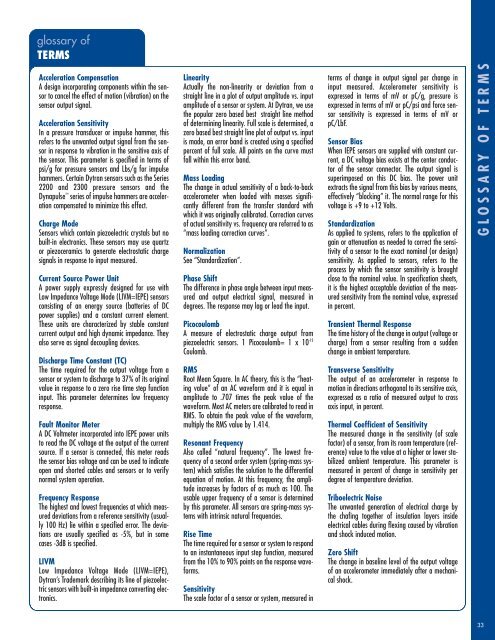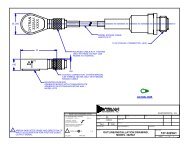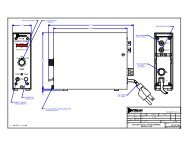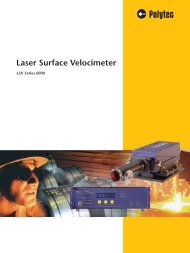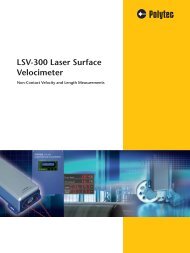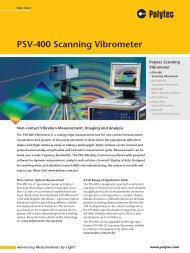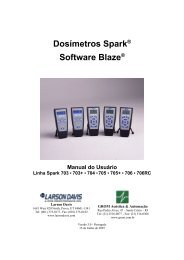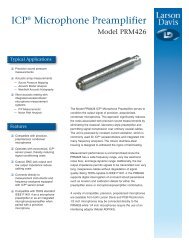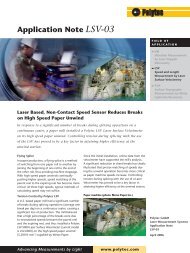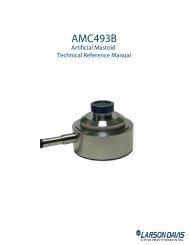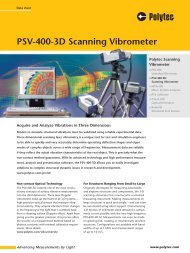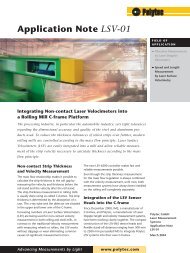accelerometers
accelerometers
accelerometers
You also want an ePaper? Increase the reach of your titles
YUMPU automatically turns print PDFs into web optimized ePapers that Google loves.
glossary of<br />
TERMS<br />
Acceleration Compensation<br />
A design incorporating components within the sensor<br />
to cancel the effect of motion (vibration) on the<br />
sensor output signal.<br />
Acceleration Sensitivity<br />
In a pressure transducer or impulse hammer, this<br />
refers to the unwanted output signal from the sensor<br />
in response to vibration in the sensitive axis of<br />
the sensor. This parameter is specified in terms of<br />
psi/g for pressure sensors and Lbs/g for impulse<br />
hammers. Certain Dytran sensors such as the Series<br />
2200 and 2300 pressure sensors and the<br />
Dynapulse series of impulse hammers are acceleration<br />
compensated to minimize this effect.<br />
Charge Mode<br />
Sensors which contain piezoelectric crystals but no<br />
built-in electronics. These sensors may use quartz<br />
or piezoceramics to generate electrostatic charge<br />
signals in response to input measured.<br />
Current Source Power Unit<br />
A power supply expressly designed for use with<br />
Low Impedance Voltage Mode (LIVM=IEPE) sensors<br />
consisting of an energy source (batteries of DC<br />
power supplies) and a constant current element.<br />
These units are characterized by stable constant<br />
current output and high dynamic impedance. They<br />
also serve as signal decoupling devices.<br />
Discharge Time Constant (TC)<br />
The time required for the output voltage from a<br />
sensor or system to discharge to 37% of its original<br />
value in response to a zero rise time step function<br />
input. This parameter determines low frequency<br />
response.<br />
Fault Monitor Meter<br />
A DC Voltmeter incorporated into IEPE power units<br />
to read the DC voltage at the output of the current<br />
source. If a sensor is connected, this meter reads<br />
the sensor bias voltage and can be used to indicate<br />
open and shorted cables and sensors or to verify<br />
normal system operation.<br />
Frequency Response<br />
The highest and lowest frequencies at which measured<br />
deviations from a reference sensitivity (usually<br />
100 Hz) lie within a specified error. The deviations<br />
are usually specified as -5%, but in some<br />
cases -3dB is specified.<br />
LIVM<br />
Low Impedance Voltage Mode (LIVM=IEPE),<br />
Dytran’s Trademark describing its line of piezoelectric<br />
sensors with built-in impedance converting electronics.<br />
Linearity<br />
Actually the non-linearity or deviation from a<br />
straight line in a plot of output amplitude vs. input<br />
amplitude of a sensor or system. At Dytran, we use<br />
the popular zero based best straight line method<br />
of determining linearity. Full scale is determined, a<br />
zero based best straight line plot of output vs. input<br />
is made, an error band is created using a specified<br />
percent of full scale. All points on the curve must<br />
fall within this error band.<br />
Mass Loading<br />
The change in actual sensitivity of a back-to-back<br />
accelerometer when loaded with masses significantly<br />
different from the transfer standard with<br />
which it was originally calibrated. Correction curves<br />
of actual sensitivity vs. frequency are referred to as<br />
“mass loading correction curves”.<br />
Normalization<br />
See “Standardization”.<br />
Phase Shift<br />
The difference in phase angle between input measured<br />
and output electrical signal, measured in<br />
degrees. The response may lag or lead the input.<br />
Picocoulomb<br />
A measure of electrostatic charge output from<br />
piezoelectric sensors. 1 Picocoulomb= 1 x 10 -12<br />
Coulomb.<br />
RMS<br />
Root Mean Square. In AC theory, this is the “heating<br />
value” of an AC waveform and it is equal in<br />
amplitude to .707 times the peak value of the<br />
waveform. Most AC meters are calibrated to read in<br />
RMS. To obtain the peak value of the waveform,<br />
multiply the RMS value by 1.414.<br />
Resonant Frequency<br />
Also called “natural frequency”. The lowest frequency<br />
of a second order system (spring-mass system)<br />
which satisfies the solution to the differential<br />
equation of motion. At this frequency, the amplitude<br />
increases by factors of as much as 100. The<br />
usable upper frequency of a sensor is determined<br />
by this parameter. All sensors are spring-mass systems<br />
with intrinsic natural frequencies.<br />
Rise Time<br />
The time required for a sensor or system to respond<br />
to an instantaneous input step function, measured<br />
from the 10% to 90% points on the response waveforms.<br />
Sensitivity<br />
The scale factor of a sensor or system, measured in<br />
terms of change in output signal per change in<br />
input measured. Accelerometer sensitivity is<br />
expressed in terms of mV or pC/g, pressure is<br />
expressed in terms of mV or pC/psi and force sensor<br />
sensitivity is expressed in terms of mV or<br />
pC/LbF.<br />
Sensor Bias<br />
When IEPE sensors are supplied with constant current,<br />
a DC voltage bias exists at the center conductor<br />
of the sensor connector. The output signal is<br />
superimposed on this DC bias. The power unit<br />
extracts the signal from this bias by various means,<br />
effectively “blocking” it. The normal range for this<br />
voltage is +9 to +12 Volts.<br />
Standardization<br />
As applied to systems, refers to the application of<br />
gain or attenuation as needed to correct the sensitivity<br />
of a sensor to the exact nominal (or design)<br />
sensitivity. As applied to sensors, refers to the<br />
process by which the sensor sensitivity is brought<br />
close to the nominal value. In specification sheets,<br />
it is the highest acceptable deviation of the measured<br />
sensitivity from the nominal value, expressed<br />
in percent.<br />
Transient Thermal Response<br />
The time history of the change in output (voltage or<br />
charge) from a sensor resulting from a sudden<br />
change in ambient temperature.<br />
Transverse Sensitivity<br />
The output of an accelerometer in response to<br />
motion in directions orthogonal to its sensitive axis,<br />
expressed as a ratio of measured output to cross<br />
axis input, in percent.<br />
Thermal Coefficient of Sensitivity<br />
The measured change in the sensitivity (of scale<br />
factor) of a sensor, from its room temperature (reference)<br />
value to the value at a higher or lower stabilized<br />
ambient temperature. This parameter is<br />
measured in percent of change in sensitivity per<br />
degree of temperature deviation.<br />
Triboelectric Noise<br />
The unwanted generation of electrical charge by<br />
the chafing together of insulation layers inside<br />
electrical cables during flexing caused by vibration<br />
and shock induced motion.<br />
Zero Shift<br />
The change in baseline level of the output voltage<br />
of an accelerometer immediately after a mechanical<br />
shock.<br />
GLOSSARY OF TERMS<br />
33


